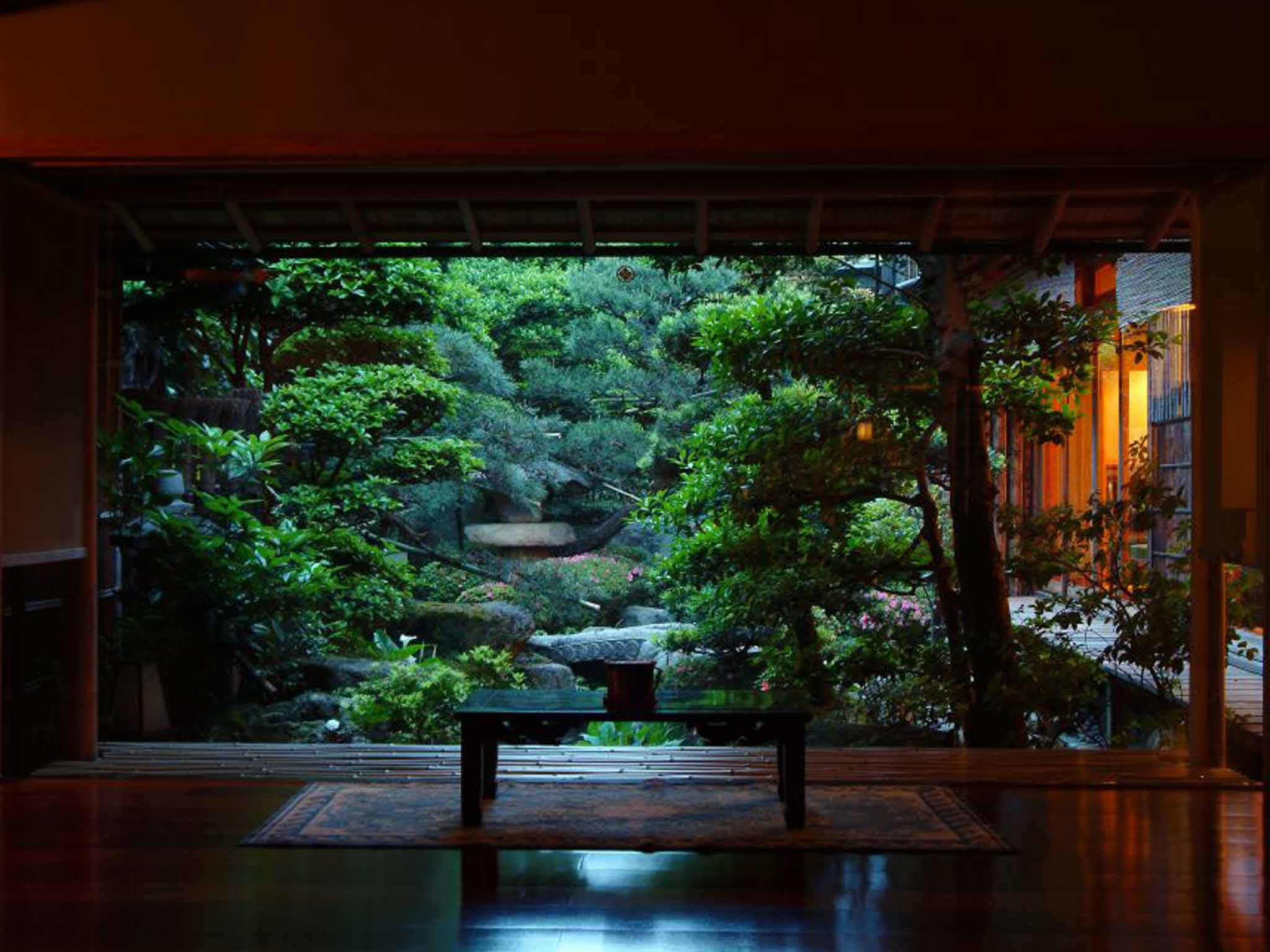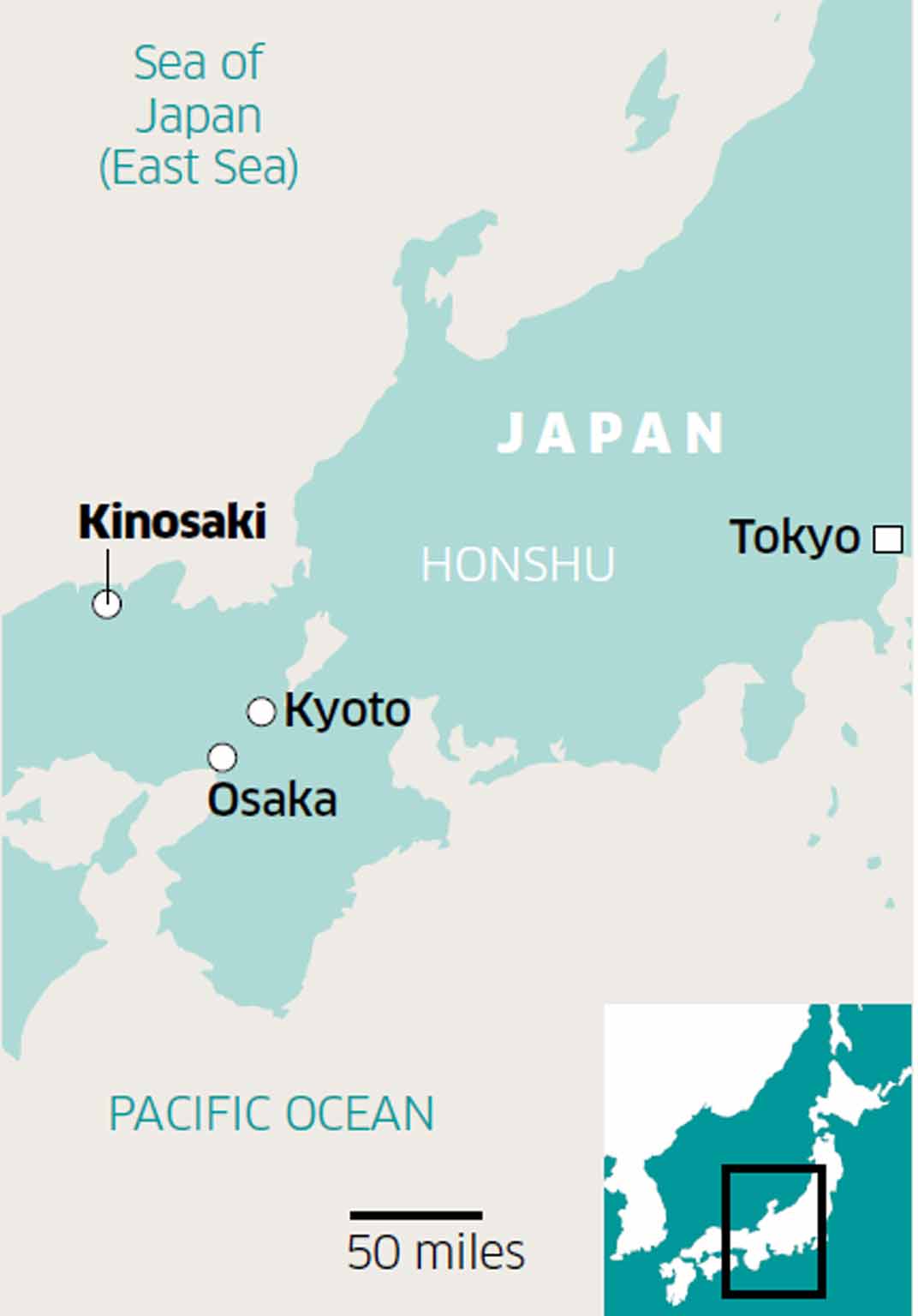Kinosaki, Japan: Journey to a town of hot springs and snow crabs
Kinosaki might be unfamiliar to the British, but for the Japanese it’s a place of pilgrimage for its thermal waters and sublime seafood. Michael Booth dipped into both

Mention the town of Kinosaki to any Japanese person and I am afraid you will likely lose them. Their eyes will glaze, a faint smile will spread across their face, and they will drift into a delicious reverie. I'll tell you where they are: either they are plucking a plump morsel of glistening leg meat from a spindly pink crustacean's limb, or they will be slowly slipping, naked, through dense steam into a piping hot onsen bath amid a serene Japanese garden.
Serious cases of Kinosaki Syndrome might require a firm shake of the shoulders or a brisk kick in the shins, but now I’ve finally been there myself, I understand the appeal of this small, one-street town nestled amid densely forested hills in the west of the country. I, too, now drift off into my own private crab-and-hot bath reverie at the mention of its name.
I arrive by train, the journey having proceeded at a most un-bullet-like local train pace for almost three hours north-west from Kyoto, and am met at the station by a staff member of the legendary ryokan - traditional Japanese inn - Nishimuraya Honkan. We drive a couple of minutes up the town’s high street, through the gates of the ryokan ... and back into the mid-19th century.
I shuffle my shoes off at the entrance and exchange them for a pair of too-small vinyl slippers. These, however, are to be removed once I’ve tottered to the entrance of my room, with its delicate tatami matting. Here, I breath my first deep sigh of content, then I simply sit.
My windows look out on to an ancient Arden of twisting pines and weeping willows which, even in the rain (especially in the rain), acts like some kind of visual balm. To sit and look and disgorge your mind of the modern world, perhaps while sipping some green tea and nibbling on a flower-shaped wagashi (Japanese confectionery), is among the chief pleasures of a stay in a ryokan.
Osaka and Kyoto are Kinosaki’s main catchments, from where the town draws an older, more wellheeled crowd, although it is also popular with groups of younger women on girls’ trips. Only recently have a few foreigners started to visit regularly. Typically, they spend their days and evenings wandering between the town’s seven onsen - public hot baths - often in their yukata, Japanese bath robes.
No one seems to know why, how, or at what point this tradition originated during the town’s 1,400-year history, but I cannot tell you how irregular it is for Japanese people to wander around in public in yukata. It is tantamount to walking down your high street in your pyjamas, but Kinosaki is a famously relaxed kind of place. There are even public foot spas on the high street where you can stop, slip off your geta (wooden clogs), rest your weary feet during the arduous 100 metres or so between onsen and, if you fancy it, cook a mesh bag of boiled eggs in the water.
The Nishimuraya has two excellent baths of its own (its larger, more modern sister hotel just up the road even has luxurious private outdoor onsen, which are among the greatest indulgences known to man), but I follow the cherry tree-lined canal that runs through the centre of Kinosaki to Satono-Yu, the largest of the town’s bath houses. Typically, it has two baths, one for men, one for women, which alternate during the day so that both genders can experience both baths.
Some things to remember when visiting the baths: take a large towel to dry yourself with and a small flannel with which to cover your modesty in the bath itself, although you can always rent them there. On arrival, you pay a small entrance fee - or enter using the pass card given to you at your ryokan - place your shoes in a locker at the door, and head for the changing room where you remove all of your clothes, taking only the flannel in with you to the bath area. There, you will find a row of ankle-high wooden stools on which you squat to wash yourself, taking special care to rinse off the soap before you enter the bath.
Easing down into the hot water you relinquish not only your neuroses and inhibitions (if you’re me, that is) but also all physical aches and pains, multifarious stresses and tensions and, ultimately, any conscious connection to the outside world whatsoever. If you are lucky you might even experience what I came to think of as the 'onsen high': after a while the heat, or perhaps it’s that sense of floating dislocation, begins to have an almost hypnotic effect.
Having dried and dressed and left the onsen, I walk the few hundred yards back up Kinosaki’s high street, past the beer and ice cream stands, and return to Nishimuraya for dinner. I have arrived during matsuba, snow crab season, which runs from November to the end of March, and so my 10 courses, plus numerous hors d’oevres presented like some edible art installation, all feature Kinosaki’s great gourmet delicacy, the food for which it is known throughout Japan.
Only male crabs are eaten, their sweet, delicate flesh served steamed, raw as sashimi, and, most hauntingly of all, harcoal grilled in front of me. There is also tajima beef, another of the region’s great delicacies; and obscurities such as butterbur, fox turnip and kogomi (fiddlehead ferns).
The most intense flavours, though, come from the kani miso. This is misleadingly translated as 'crab brains', but is actually their guts and various organs (really, if crabs’ brains were this big, we’d have seriously underestimated their intelligence). This pungent brown gloop – I am really selling it, aren’t I? – packs a funky, savoury punch.
I also have an unexpectedly interesting time at the Konotori no Sato stork sanctuary, around 10km south of Kinosaki. Having heard the rather moving story of how the final remaining Japanese stork storked its last in 1971 - after its food supply had been killed off by modern farming practices - seeing the footage of those birds charged with repopulating the country being released into the wild a few years back, and then going outside to view about 20 of this majestic species, with their two metre wing spans, circling above me, leaves me properly beguiled.

A short drive south-east is the town of Izushi, which has two claims to fame. The first is an atmospheric old kabuki theatre, Eirakukan, built in 1901 and a rare survivor of fires and earthquakes. The second: Izushi sara soba, traditional buckwheat noodles, served here - for reasons lost in the mists of time, and despite it patently being a bad way to serve soba - in individual, bite-sized portions, each in their own small dish.
I try them for lunch in one of the two restaurants that specialise in them, diligently slurping my way through tiny saucer after tiny saucer of increasingly chilly noodles. One for list-tickers only, I suspect.
Before I leave Nishimuraya Honkan the next morning, an elderly man approaches me. He looks like a retired Japanese James Bond, straight-backed with a perfect head of silvery hair and wearing an impeccably pressed suit. This is Mr Nishimura himself, the sixth generation owner of the ryokan, and a former mayor of Kinosaki. We perform an awkward bowing-hand shaking routine before he invites me to sit with him in the lounge.
I ask him the secret of Japanese ryokan hospitality, and he ponders a moment: "I was born here. We have 70 staff," he says slowly. "The staff are like family. They stay. And the guests also come back, generation after generation." I imagine my own family returning, generation after generation, to this magical town, this magical inn. It is a lovely thought and I breathe another deep, contented sigh.
Getting there
Michael Booth travelled from Heathrow to Osaka via Helsinki with Finnair (0870 241 4411; finnair.co.uk).
Staying there
Nishimuraya Honkan (nishimuraya.ne.jp). Double rooms start at Y50,000 (£267).
More information
Michael Booth’s latest book, The Almost Nearly Perfect People: The Truth About the Nordic Miracle is published by Jonathan Cape. His book about Japanese food, Sushi and Beyond (Vintage) is available in paperback.
Join our commenting forum
Join thought-provoking conversations, follow other Independent readers and see their replies
Comments
Bookmark popover
Removed from bookmarks